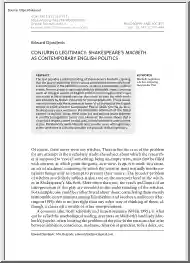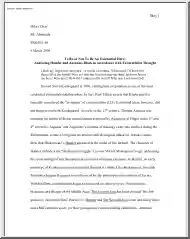No comments yet. You can be the first!
What did others read after this?
Content extract
HAMLET ACT II Characters Match each character’s name with his/her description. 1) Polonius a) understands her son’s “distemper” better than most of the other characters 2) Reynaldo b) frightened by Hamlet’s strange behavior 3) Ophelia c) under pressure, admits to being summoned by the king and queen 4) Claudius d) sent to France to spy on Laertes 5) Gertrude e) brings good news from Norway 6) Voltimand f) plans to spy on his own son and daughter 7) Rosencrantz g) gives a convincing preview performance from a Greek tragedy 8) Guildenstern h) asks Hamlet’s friends to watch him 9) Hamlet i) admits that he knows a “hawk from a handsaw” 10) 1st Player j) tells Hamlet that the players have arrived Literary Devices 11) Archetype a) character’s struggle with his own conflicting emotions or desires 12) Aside b) distributor of divine justice 13) Comic Relief c) personality trait that
causes a character’s ultimate downfall 14) External Conflict d) universal pattern or prototype 15) Foreshadowing e) recurring theme or dominant idea in literature 16) Internal Conflict f) character’s physical or verbal struggle with another character 17) Motif g) object that represents both itself and something else 18) Nemesis h) dramatic device in which a character whispers quietly to another on stage 19) Symbol i) clues giving hints of a story’s outcome 20) Tragic Flaw j) episodes that both relieve the tension and heighten the tragedy of a literary work Scene 1 11) Polonius sends his servant Reynaldo to France in order to obtain what information? 12) During this scene, Ophelia rushes in to tell her father about what strange occurrence? 13) How does Polonius interpret this event? Scene 2 14) and have been summoned by the king and queen, presumably from Wittenberg, for
what reason? 15) What good news from Norway does Voltimand bring to King Claudius? 16) Polonius uses the famous line “Brevity is the soul of wit” to describe how quickly he will reveal what important information concerning Hamlet to Claudius and Gertrude? 17) The quotation in #16 is an example of what literary device? 18) Why is the line ironic? 19) What document does Polonius read aloud to Claudius and Gertrude? How does he interpret its contents? 20) Claudius and Polonius decide to test the latter’s theory by making arrangements to spy on a conversation between which two characters? 21) How does Hamlet convince Polonius that he is mad for the love of the latter’s daughter? 22) When Polonius delivers his famous line, “Though this be madness, yet there is method in’t,” why is it ironic? 23) When Hamlet greets Rosencrantz and Guildenstern, the three young men use a rather risqué analogy in which is personified as a beautiful prostitute.
24) What does Hamlet compel his friends to admit concerning their sudden appearance at Elsinore? 25) Hamlet’s famous speech, which begins with the line, “What a piece of work is a man!” and ends with “And yet, to me, what is this quintessence of dust?” is an example of what type of extended speech? 26) In most stage and film productions, Hamlet’s mood noticeably brightens when he sees the arrival of the players; in fact, he is often portrayed as being a frustrated actor and playwright himself. What evidence in this scene points to this interpretation? 27) In what lines could it be argued that Shakespeare himself may be speaking through the character of Hamlet? 28) What favor does Hamlet ask of the player? 29) Hamlet’s last speech in this scene, which begins with the lines, “Now I am alone. O, what a rogue and peasant slave am I!” is an example of what type of speech? 30) How does Hamlet unfavorably
contrast his behavior to that of the player here? 31) Hamlet uses what unflattering simile to condemn his lack of action here? 32) Hamlet decides to test the veracity of the ghost’s words. Why? 33) How will he do so? 34) Write the rhymed couplet used to end Act II here. 35) What other literary device does it represent? Identification and Interpretation of Literary Devices 36) Explain the significance of the allusion to Hecuba. 37) Explain the reasons why there are four asides in Act II. 38) Both Claudius and Polonius’ plan in scene i and Hamlet’s plan in scene ii are examples of which literary device? 39) How is Fortinbras presented as a foil to Hamlet? 40) In his final speech in Act II, Hamlet uses what Biblical allusion?
causes a character’s ultimate downfall 14) External Conflict d) universal pattern or prototype 15) Foreshadowing e) recurring theme or dominant idea in literature 16) Internal Conflict f) character’s physical or verbal struggle with another character 17) Motif g) object that represents both itself and something else 18) Nemesis h) dramatic device in which a character whispers quietly to another on stage 19) Symbol i) clues giving hints of a story’s outcome 20) Tragic Flaw j) episodes that both relieve the tension and heighten the tragedy of a literary work Scene 1 11) Polonius sends his servant Reynaldo to France in order to obtain what information? 12) During this scene, Ophelia rushes in to tell her father about what strange occurrence? 13) How does Polonius interpret this event? Scene 2 14) and have been summoned by the king and queen, presumably from Wittenberg, for
what reason? 15) What good news from Norway does Voltimand bring to King Claudius? 16) Polonius uses the famous line “Brevity is the soul of wit” to describe how quickly he will reveal what important information concerning Hamlet to Claudius and Gertrude? 17) The quotation in #16 is an example of what literary device? 18) Why is the line ironic? 19) What document does Polonius read aloud to Claudius and Gertrude? How does he interpret its contents? 20) Claudius and Polonius decide to test the latter’s theory by making arrangements to spy on a conversation between which two characters? 21) How does Hamlet convince Polonius that he is mad for the love of the latter’s daughter? 22) When Polonius delivers his famous line, “Though this be madness, yet there is method in’t,” why is it ironic? 23) When Hamlet greets Rosencrantz and Guildenstern, the three young men use a rather risqué analogy in which is personified as a beautiful prostitute.
24) What does Hamlet compel his friends to admit concerning their sudden appearance at Elsinore? 25) Hamlet’s famous speech, which begins with the line, “What a piece of work is a man!” and ends with “And yet, to me, what is this quintessence of dust?” is an example of what type of extended speech? 26) In most stage and film productions, Hamlet’s mood noticeably brightens when he sees the arrival of the players; in fact, he is often portrayed as being a frustrated actor and playwright himself. What evidence in this scene points to this interpretation? 27) In what lines could it be argued that Shakespeare himself may be speaking through the character of Hamlet? 28) What favor does Hamlet ask of the player? 29) Hamlet’s last speech in this scene, which begins with the lines, “Now I am alone. O, what a rogue and peasant slave am I!” is an example of what type of speech? 30) How does Hamlet unfavorably
contrast his behavior to that of the player here? 31) Hamlet uses what unflattering simile to condemn his lack of action here? 32) Hamlet decides to test the veracity of the ghost’s words. Why? 33) How will he do so? 34) Write the rhymed couplet used to end Act II here. 35) What other literary device does it represent? Identification and Interpretation of Literary Devices 36) Explain the significance of the allusion to Hecuba. 37) Explain the reasons why there are four asides in Act II. 38) Both Claudius and Polonius’ plan in scene i and Hamlet’s plan in scene ii are examples of which literary device? 39) How is Fortinbras presented as a foil to Hamlet? 40) In his final speech in Act II, Hamlet uses what Biblical allusion?




